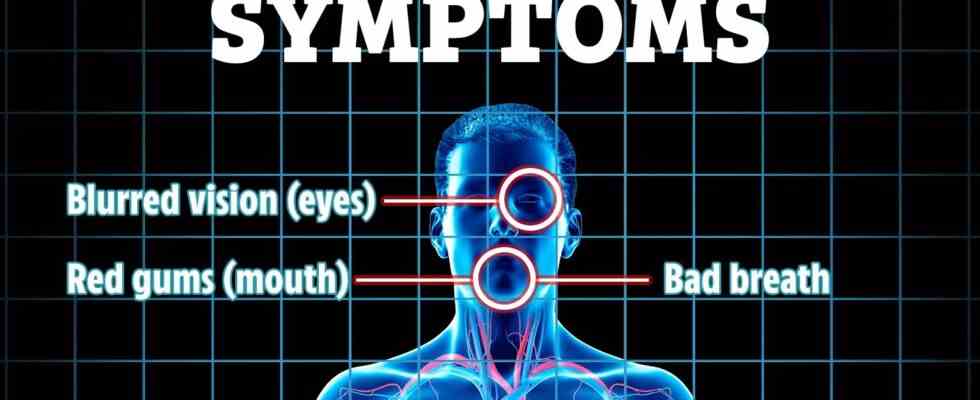ONE million people have diabetes and have no idea.
Another 13.6 million people are at risk of getting it and should be aware of the signs to look out for.
If you are diabetic, your body may have trouble making enough insulin (type 1) or the insulin may not be effective (type 2).
In the UK, around 90 percent of adults with type 2 diabetes have type 2 diabetes.
Diabetes needs to be treated to prevent blood sugar levels from getting dangerously high.
But some people can go years before they’re even diagnosed.
The NHS says: “Many people have type 2 diabetes for years without realizing it because the early symptoms are rather general.”
The longer blood sugar levels remain elevated, the greater the likelihood of complications.
This can affect almost every part of your body, including the heart, kidneys, blood vessels, eyes, nerves, gastrointestinal tract, gums, and teeth.
This week is diabetes week – use this full body scan to check you’re not living with signs of untreated diabetes.
EYES
If your eyes have become blurry or wavy, it doesn’t necessarily mean you need a new prescription — it’s a key symptom of diabetes.
High glucose levels can change fluid levels or cause swelling in the tissues of your eyes that help you focus and cause distorted vision.
It is temporary and will go away once glucose levels return to normal.
People who have had diabetes for a long time are at risk of developing diabetic retinopathy, which usually develops over years but can lead to prediabetes.
This happens because too much sugar in the blood over time blocks the tiny blood vessels that feed the retina (the back of the eye).
It could lead to vision loss.
MOUTH
Dentist and Clinical Director of Bupa Dental Care, Dr. Sarah Ramage previously told The Sun that people with type 2 diabetes are three times more likely to have problems with their oral health than those who don’t have the disease.
“Diabetics produce less saliva, which prevents attacks on tooth enamel, and saliva may contain higher levels of sugar — an increased risk of tooth decay,” she said.
dr Ramage said people with the condition have a higher risk of gum disease.
The condition can often go undetected and can be difficult to spot, as signs can be brushed off as something else.
But there are signs in your mouth to look out for.
These include swollen, red, receding gums, or gums that bleed when you brush your teeth.
Tooth loss, bad breath and wounds that take longer to heal than usual – such as after a dental procedure – are other signs.
The most common signs of diabetes
The most common signs of diabetes are:
- Peeing more than usual, especially at night
- Constant feeling of thirst
- feeling very tired
- Lose weight without trying
- itching around your penis or vagina or repeated occurrences of thrush
- Cuts or wounds that take longer to heal
- Blurred vision
FOOT
Everyone gets tingling in their feet from time to time.
But be careful, tingling, pain or numbness in the hands or feet is a symptom of diabetes, even in the early stages.
People with diabetes have a higher long-term risk of foot problems due to nerve and blood vessel damage.
Redness, warmth, and swelling are three signs that indicate nerve damage in the feet, according to the National Institute of Diabetes and Digestive and Kidney Diseases.
Over the long term, high blood sugar levels can damage nerves throughout the body, known as diabetic neuropathy, the most common of which is peripheral neuropathy.
In most diabetics, this damages the nerves in the feet and legs and is most noticeable at night.
The main signs are numbness, reduced sensitivity to pain or temperature changes, tingling, cramps, tenderness and serious foot problems.
HANDS
Diabetic neuropathy can also affect the hands.
In peripheral neuropathy, it tends to cause symptoms such as numbness in the feet and legs first, followed by the hands and arms.
Extreme sensitivity to touch – for some people, even the weight of a bed sheet can be painful.
SKIN
Skin disorders are common in diabetics due to high blood sugar levels affecting your blood vessels and nerves.
More commonly, patients pre-diagnose a condition known as acanthosis nigricans (AN).
It is characterized by a dark band of velvety skin that usually appears on the nape of the neck.
dr Julietta Gusarova, a cosmetic doctor who works with RegenLab, told The Sun: “Acanthosis nigricans can also be spotted in many people in different places on the body where the skin folds, such as the shoulders. B. the palms, armpits or groins.
“In addition to the visible coloring associated with the disorder, some people say their skin feels thicker.”
GENITALS
Diabetes affects so many aspects of a person’s health, including their sex life.
One of the most common signs of the condition is thrush — a common yeast infection — in both men and women.
Thrush causes irritation, redness, and itching around the genitals and white discharge (like cottage cheese).
Women may feel a stinging sensation when peeing or having sex, while men have trouble retracting their foreskin.
dr Agnieszka Nalewczynska, a consultant gynecologist who works with RegenLab, added, “Women with diabetes are also more prone to periodic urinary tract infections (UTIs), which can make sex more painful and uncomfortable.”

